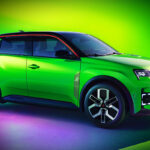The Espace was the only purpose-built European multi-purpose vehicle popularly called a people mover. It had a short bonnet angled the same as the windscreen so that both bonnet and windscreen formed a straight line down to the grille. The front wheels were driven by the same 1995cc in-line engine as used in Renault 21 and 25 saloons. It had the best performance of all the people-carriers with a top speed of 160 km/h and good handling but with a certain amount of roll.
The Renault Espace used a longitudinal engine to drive the front wheels. It had three rows of seats with the capability of turning around the front seats for use as a conference location. From 1988 the Espace was also offered as a four-wheel drive.
From the 1950s most major automobile manufacturers included station wagons in their range, which combined the carrying capacity of a van with the performance of a saloon on which they were based. Some carried this concept a little further by also producing a panel van on the same floor plan. However these lack headroom and most are confined to two rows of seats, allowing only a maximum of five or at most six passengers if a full bench seat is used in the front.
In 1982 Nissan introduced a new concept in vehicles called the Prairie. This had a much higher roof than a wagon and offered more luggage space although only two rows of seats. The passenger doors slid rather than opening in the usual way. This feature was copied also in the Toyota Space Cruiser that also provided three rows of seats. Mitsubishi introduced the Space Wagon in 1983, also with three rows of seats but with a smaller luggage area than in the Nissan Prairie.
America entered the people-carrier market later than Japan or Europe. First in the field was the 1984 Dodge Caravan – also badged as the Chrysler Voyager – followed by the Chevrolet Astro and in 1986 the Ford Aerostar. The Dodge (Chrysler) had a transverse engine driving the front wheels, but the other two American entries had longitudinal engines and rear-wheel drive. All were also made in panel van form and as station wagons.
The Chevrolet Lumina introduced in 1990 and also sold with Oldsmobile and Pontiac badges had a 120 bhp 3128 cc fuel-injected V6 engine mounted transversely under an Espace-like short bonnet, driving the front wheels. Its fibreglass body had two doors on the near side and only one for the driver on the offside.
The Espace continues in the Renault range to this day and still serves as the benchmark by which many other MPVs are measured.











